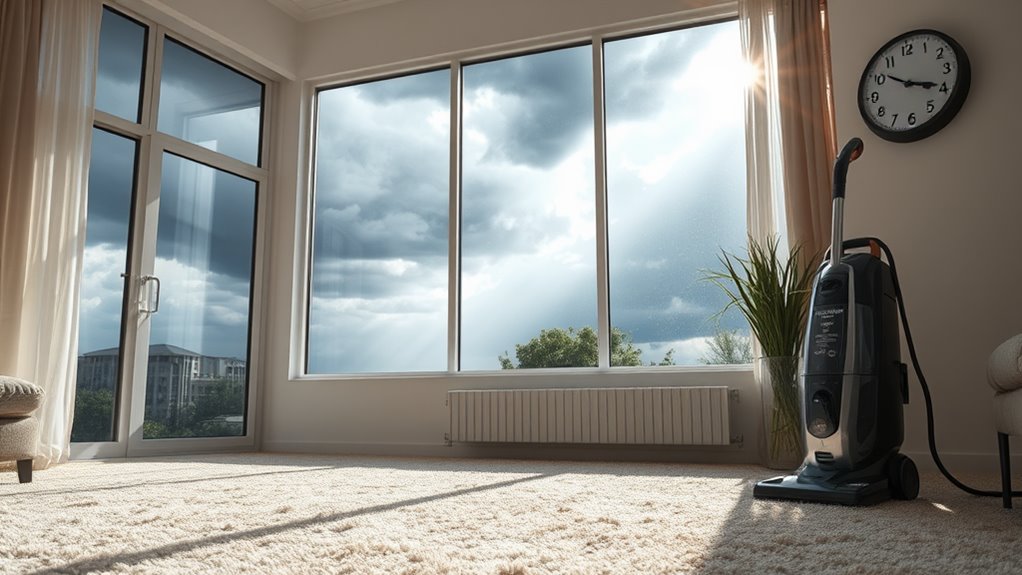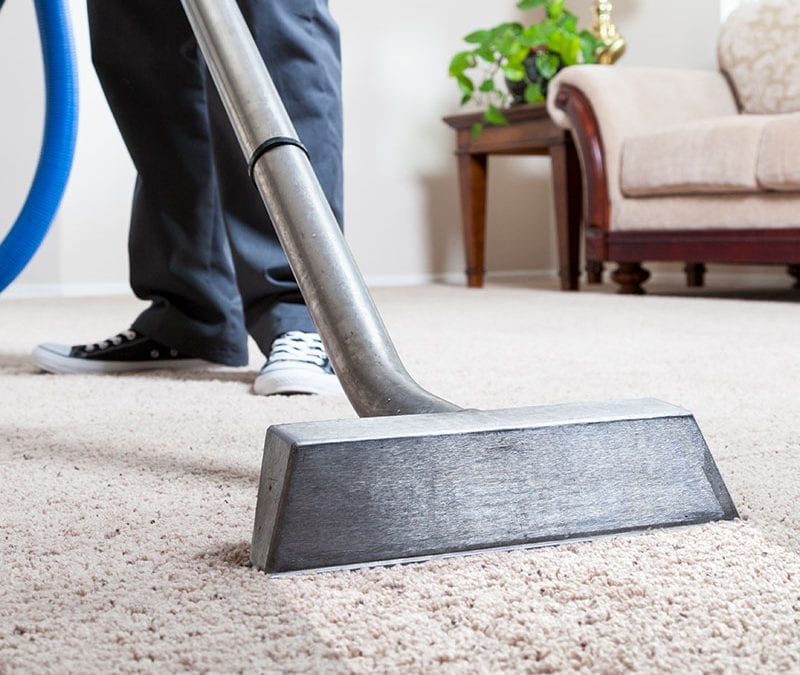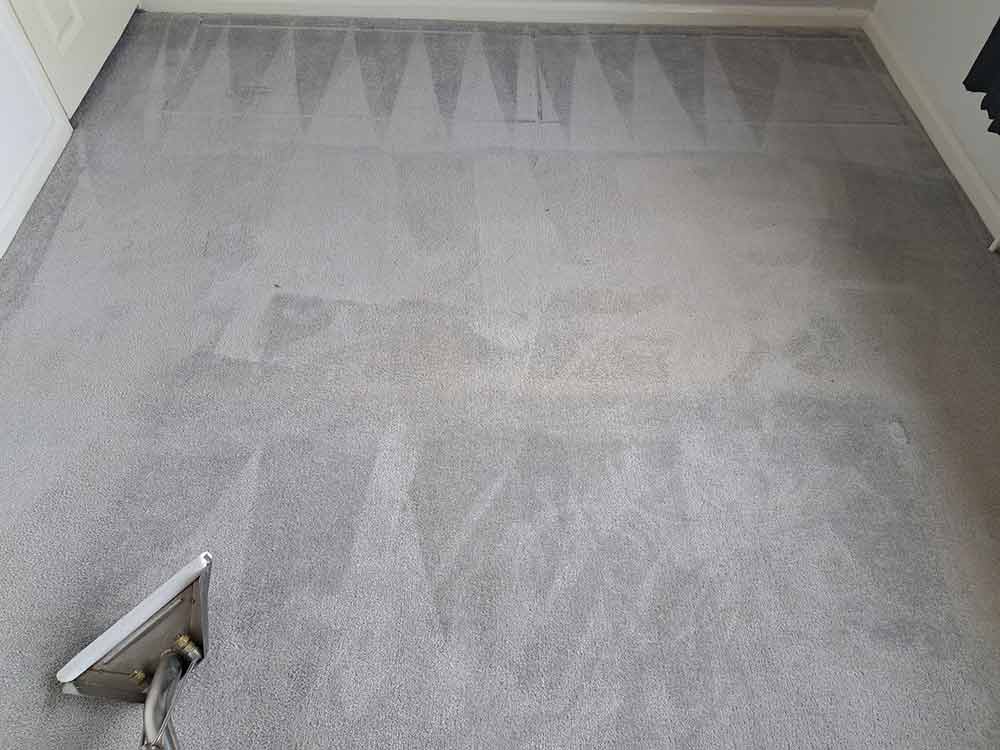Much like a well-composed symphony, your carpet cleaning schedule needs to harmonize with the changing seasons. Think about how weather elements—humidity, rain, and even pollen—can dramatically affect when and how you clean your carpets. You might not realize it, but a simple rainstorm could throw off your entire routine, leading to potential issues like mold or allergens accumulating in your home. So, how do you adapt your cleaning strategy to these unpredictable shifts?
Seasonal Considerations for Cleaning
When considering seasonal carpet cleaning, it's vital to recognize how different weather conditions impact your home environment.
In spring, the surge in spring allergens like pollen and dust makes deep cleaning essential. You'll want to vacuum at least twice a week and use a vacuum with HEPA filters to effectively capture those particles. Spot cleaning spills immediately is also important to maintain freshness.
As summer rolls in, summer moisture can lead to mold and mildew growth. Regular vacuuming helps manage the dirt and debris tracked indoors from outdoor activities, while dehumidifiers can greatly reduce moisture levels. It's advisable to schedule frequent cleaning to combat the effects of humidity and keep carpets in optimal condition.
Fall maintenance is key for preparing your carpets for winter. By scheduling professional cleaning now, you can remove accumulated dust and prevent long-term damage. Pay attention to leaves and debris that may find their way inside as the seasons change.
Finally, winter protection becomes paramount. Frequent vacuuming is necessary to eliminate salt and moisture that can damage carpets. Using mats at doorways can help minimize the amount of snow and salt brought indoors, ensuring your carpets stay clean and well-maintained throughout the colder months.
Ideal Times for Deep Cleaning
Deep cleaning your carpets at strategic times can greatly enhance their longevity and maintain a healthy living environment. To determine the ideal deep cleaning frequency, consider factors like foot traffic, allergies, and your household habits.
High-traffic areas, especially those with kids or pets, often require deep cleaning every 2 to 3 months. For homes with smokers or frequent gatherings, aim for every 3 to 6 months to tackle stains and dirt effectively.
Spring and fall present excellent opportunities for deep cleaning, as they align with seasonal changes and increased allergens. Cleaning in spring helps remove pollen and dust that accumulate during the warmer months, while fall prepares your carpets for the winter's wet conditions.
Even low-traffic areas should be deep cleaned at least once a year to eliminate hidden dust and environmental contaminants. Regularly scheduled cleaning helps reduce allergens and pollutants, which is particularly beneficial for maintaining a healthy home environment.
Following these frequency recommendations and timing your deep cleaning efforts can greatly improve indoor air quality and extend the life of your carpets. Regular professional cleaning every 6 to 12 months ensures your carpets stay in top condition, addressing any weather-related challenges that arise throughout the year.
Weather-Related Challenges
Weather can remarkably impact the condition of your carpets, making it essential to adapt your cleaning strategies accordingly. Different weather patterns bring unique challenges that can affect carpet cleanliness and longevity.
For instance, wet conditions from rain or snow elevate humidity levels, which can slow down drying times and increase the risk of mold and mildew growth. You may notice that during these times, carpets trap more dirt and moisture, making regular cleaning critical.
Furthermore, seasonal changes exacerbate these issues. Spring brings pollen and dust, while summer's high humidity can lead to deeper moisture absorption in carpets. In fall, leaves and debris tracked indoors can stain fibers, and winter mud can embed deeply, complicating cleaning efforts.
To combat these weather-related challenges, it's essential to implement a proactive cleaning schedule. Regular maintenance not only helps prevent build-up but also mitigates moisture-related risks. Proper air circulation can also significantly enhance drying times after cleaning, reducing the likelihood of mold development.
Adjusting your cleaning frequency based on current weather conditions and utilizing proper equipment, like dehumidifiers and fans, can markedly improve outcomes. By staying aware of the weather and its impact, you can keep your carpets clean and in excellent condition year-round.
Environmental Impact of Cleaning
Carpet cleaning's environmental impact is a fundamental consideration for both homeowners and cleaning professionals alike. Traditional methods often rely on chemical-based products that contribute greatly to pollution. These chemicals can harm aquatic life and contaminate essential water sources, posing health risks to both humans and the environment. By opting for non-toxic, biodegradable chemical alternatives, you can minimize this impact and promote eco-friendly practices.
Moreover, water consumption during carpet cleaning processes can strain local resources. Techniques like steam cleaning consume considerable amounts of water, leading to increased energy use for heating. Switching to low-moisture methods not only conserves water but also reduces drying time, saving energy and lowering your carbon footprint.
Waste generation is another fundamental factor. Carpet cleaning produces waste, including used solution containers. Incorporating responsible waste management practices, such as recycling programs and eco-friendly packaging, is essential for sustainability.
Lastly, prioritize health and indoor air quality by choosing cleaning methods that reduce airborne pollutants. Using HEPA-filter vacuums and ensuring proper ventilation can enhance indoor environments while adhering to eco-friendly practices. By being proactive, you contribute to a healthier planet. Additionally, utilizing natural cleaners like vinegar can further minimize harmful effects on the environment.
Factors Affecting Cleaning Costs

When considering the costs associated with carpet cleaning, various factors come into play that can greatly impact your final bill.
First, the size and location of the room are essential. Larger spaces demand more resources, while local market rates can dictate the price per square foot. If you live in an urban area, expect higher costs due to competition and living expenses.
Next, the condition of your carpet matters considerably. Heavily soiled carpets may need pre-treatment and specialized techniques, which can raise your cleaning costs. Additional services, such as stain removal and odor control, also contribute to the overall expense.
The cleaning method you choose influences pricing strategies as well. Different techniques—like dry cleaning or hot water extraction—come with varying costs, as do the expertise and equipment required. Established companies may charge more due to their reputation and quality.
Finally, seasonal demand can affect your cleaning costs. Spring and fall often see a surge in requests, leading to higher prices. Furthermore, utilizing professional carpet cleaning services can ensure a thorough job, potentially saving you money on future repairs.
To manage these costs effectively, prioritize regular carpet maintenance and plan your cleaning schedule wisely.
Frequently Asked Questions
How Does Humidity Affect Carpet Cleaning Methods?
Humidity levels greatly influence your carpet cleaning techniques. High humidity slows drying times, necessitating low-moisture methods and improved air circulation. Monitoring humidity helps you choose effective cleaning techniques and prevents mold growth and moisture retention.
Can I Clean My Carpets During Heavy Rain?
You can clean your carpets during heavy rain, but consider carpet moisture levels. Use efficient cleaning equipment like truckmounts and air movers to manage humidity and guarantee quick drying to prevent mold growth and damage.
What Weather Conditions Delay Carpet Drying Times?
Ironically, the very weather factors you'd love for a sunny day can delay your carpet drying. High humidity and cold temperatures create unfavorable drying conditions, extending the time it takes for your carpets to dry completely.
Does Carpet Cleaning Differ in Cold Versus Warm Weather?
Yes, carpet cleaning does differ. Cold weather challenges include slower drying times, while warm weather advantages allow for quicker drying and reduced mold risk. You should adjust your cleaning schedule to maximize these seasonal benefits.
How Can I Prepare My Home for Carpet Cleaning?
Like a painter preparing a canvas, you should tackle a pre-cleaning checklist. Start with furniture removal, ensuring clear pathways. Vacuum thoroughly, identify stains, and protect fragile items to create an ideal environment for carpet cleaning.
Conclusion
To summarize, adjusting your carpet cleaning schedule based on weather conditions isn't just smart—it's essential for maintaining your carpets' longevity and your home's air quality. Have you considered how seasonal changes might be affecting your indoor environment? By staying proactive and aware of the unique challenges each season brings, you can guarantee your carpets remain clean, fresh, and free from allergens. Don't let the weather dictate your carpet's health; take charge and plan accordingly!



